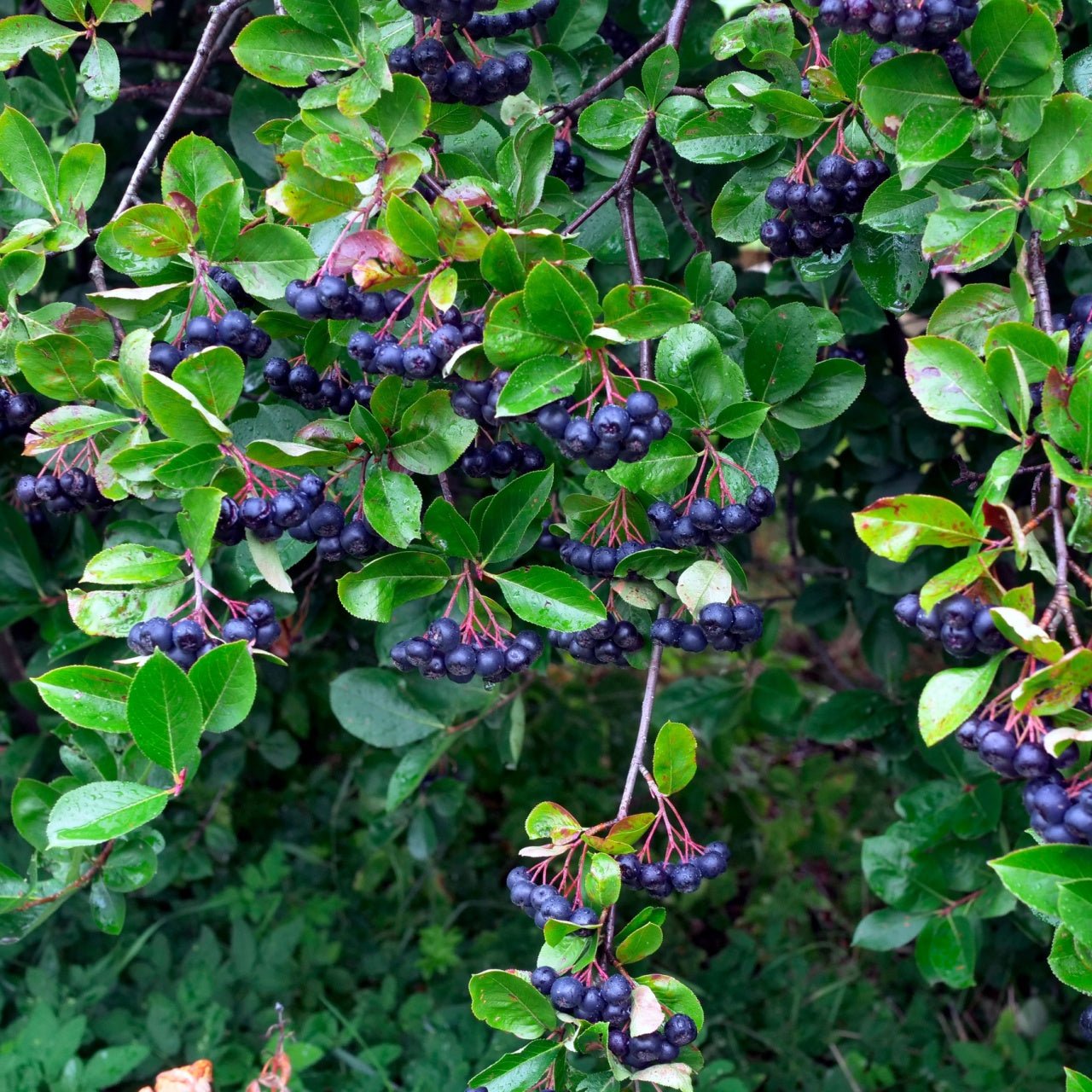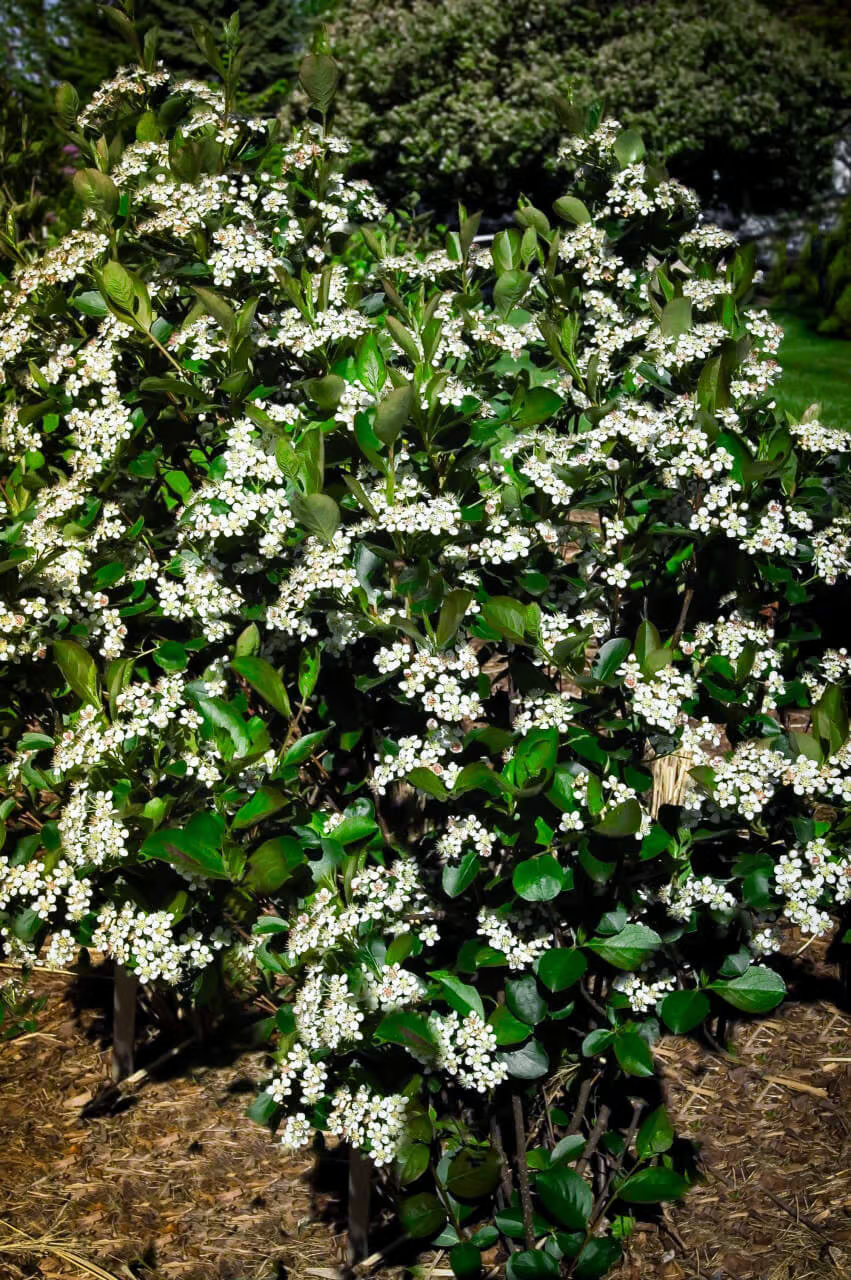



Black Chokeberry
Attractive, four-season visual interest
Drought-tolerant and low-maintenance
Versatile in various soil types
Thrives in
ZONE 5ZONE 6ZONE 7ZONE 8ZONE 9ZONE 10This plant ships:
November 20251 Year Guarantee on all plants
Black Chokeberry - Aronia melanocarpa
Black Chokeberry (Aronia melanocarpa) is a colorful deciduous shrub native to eastern North America. It grows naturally in swamps, bogs and low woodlands; however, it can be found in dry uplands as well. Its growth habit is often upright and rounded, reaching approximately 6 ft in height. The bright green leaves of this shrub are a rounded ovate shape with fine serration along the edges. In the autumn, the foliage transitions to a beautiful red color which contrasts with the black berries that persist throughout the season.
Plant Details - Black Chokeberry
Family: Rosaceae (Rose family)
Hardiness Zones: 3–8
Light Requirement: Full sun to partial shade
Water Needs: Moderate
Height: 3 - 6 ft
Spread: 3 - 6 ft
Growth Rate: Moderate
Bloom Time: Late spring
Flower Color: White
Wildlife Value: Attracts pollinators (bees and butterflies), berries are a vital food source
The Black Chokeberry produces flower clusters in late spring in groups of 5 to 6. Each flower has a dainty appearance, consisting of 5 stark white petals and bright pink stamens. Once pollinated, clusters of berries form. While the fruit is quite astringent, it is edible and has a myriad of uses.
The common name ‘chokeberry’ pays homage to the berries’ astringent and tart taste that make you ‘choke’ when you eat them. The berries are extremely high in antioxidants and are usually sweetened to be made palatable. They are commonly used to make jams, or chutneys, and can even be used to make wine.
Landscape Uses and Maintenance - Black Chokeberry
It is low maintenance, easy to grow, and has no known serious pest or disease issues. It tolerates many different soil conditions, including soggy environments, and will grow in either full sun or part shade. Best fruit production will be achieved in full sun.
This plant spreads via sucker and can expand quickly. These suckers will need to be removed regularly if you desire for them to remain in a confined space. In a garden setting, it can be used in a mixed shrub border or in a woodland transition area.
Noteworthy Characteristics
Edible berries, colorful autumn transition, easy to grow
Plant this shrub in your garden to enjoy colorful autumn foliage and tart berries year after year. Shop for Black Chokeberry shrubs online at TN Nursery. For 68 years, we have served the landscaping industry and homeowners with specimen plants.
This Is How Your Plants Will Look upon Delivery

Bloom Season
Spring
Bloom/Foliage Color
White
Height at Maturity
Under 10 Feet
Care
Black Chokeberry (Aronia melanocarpa) thrives in well-drained soil and requires regular watering. Prune yearly to maintain shape and clear dead or diseased wood. It’s generally pest-resistant, but watch for common garden pests and treat as needed. Fertilize in early spring.
Plant Reproduction
Black Chokeberry spreads via root suckers, forming dense thickets.
Plant bare-root shrubs during the more excellent spring or fall months, from November through April. Dig a hole twice as wide as the root system and slightly more profound than its height. Position the shrub so that the top of the roots is level with the ground, and put back the soil dug over the roots. Apply a 2-3 inch layer of mulch around the base to retain moisture and suppress weeds, ensuring the mulch does not touch the shrub's stem. Water regularly, especially during the first year, to establish strong roots. Prune shrubs as needed to promote healthy growth. In the spring, fertilize with a balanced, slow-release fertilizer suited to the specific needs of the shrub.
Shipping date depends on the date displayed and chosen when you order from the product's page.
We only accept returns on plants verified dead. If you think your plants have died, we offer a 1 year warranty, please use this File a Claim Link to verify dead plants and start with return warranty process.






Hardy and Resilient:
Known for its durability, Black Chokeberry thrives in various soil types and weather conditions. Its ability to withstand cold temperatures and challenging environments makes it a reliable addition to any garden.
Nutrient-Rich Berries:
The berries of Black Chokeberry are not only attractive but also packed with nutrients and antioxidants. They can be used in a variety of culinary applications, including jams, jellies, and health drinks.
Low Pest Issues:
Black Chokeberry is generally resistant to pests and diseases, reducing the need for chemical treatments and ensuring a healthier garden. This makes it a practical and eco-friendly choice for gardeners.
Erosion Control:
Black Chokeberry’s robust root system helps stabilize soil, making it an excellent choice for erosion control. This is particularly beneficial in areas prone to soil erosion or on slopes.
Caring Tips
How do I care for my Black Chokeberry?
Each box contains detailed care instructions and information about your product. But here's the basics.
Care Tips
Black Chokeberry (Aronia melanocarpa) thrives in well-drained soil and requires regular watering. Prune yearly to maintain shape and clear dead or diseased wood. It’s generally pest-resistant, but watch for common garden pests and treat as needed. Fertilize in early spring.
Light Requirements
Black Chokeberry (Aronia melanocarpa) flourishes in full sun to part shade. It favors at least 4-6 hours of direct sunlight per day for best growth and fruit production, but it can tolerate some shade, especially in hotter climates.
Hardy Planting Zones
5 • 6 • 7 • 8 • 9 • 10
Header
Use this content to share information about your store and products.
Frequently Asked Questions
How often should I water my plants?
How do I know if my plant is getting too much or too little sunlight?
What should I do to prepare my plants for winter?
What are the signs that my plant needs fertilizing?
How can I prevent pests from damaging my plants?
How do I choose the right plant for my climate zone?






